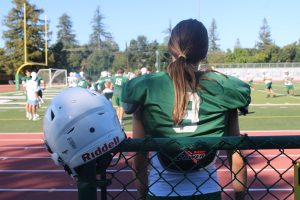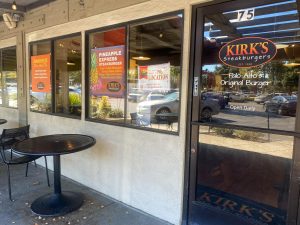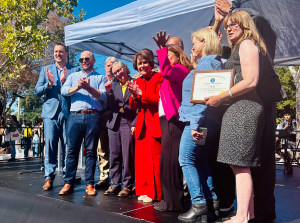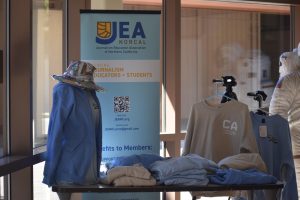Podcast: Choir students discuss highs and lows of virtual learning
March 29, 2021
In this first episode of Voice Asks Paly, Daniel, Emily, and Arohi sit down with members of the various choir groups at Palo Alto High School to discuss the shift to virtual learning and their plans for the future.
Listen to the podcast using the player below, or click here to listen in a new window. This episode as well as all further episodes of this podcast will be available on Apple Podcasts, Spotify, or wherever you get your podcasts. (Note: Some podcast platforms may take longer to publish new episodes.)
Podcast Transcript
Emily Yun: From the Paly Voice, I’m Emily Yun,
Daniel Garepis-Holland: I’m Daniel Garepis-Holland,
Arohi Bhattacharya: And I’m Arohi Bhattacharya.
Daniel Garepis-Holland: And this is Voice Asks Paly.
[MUSIC PLAYS]
Daniel Garepis-Holland: Today, we sit down with three members of the Festival and Madrigals choir, as well as conductor Michael Najar, to talk about how the Palo Alto High School Choir has been adapting to the virtual environment. First, would you guys like to introduce yourselves?
Gabi Wilkinson: Hi, my name is Gabi Wilkinson. I am a senior, and I am in Festival choir and Madrigals choir.
Edie: Hi, my name is Edie Gollub. I’m also a senior and I am in Festival choir and Madrigals.
Veronica: Hello, I’m Veronica [Bain]. I’m in Festival choir and Madrigals choir and also Heartbeats Acapella.
Arohi Bhattacharya: I think we can all agree that calling this the new normal feels weird because it’s such an unprecedented experience. Every class and every individual has been encountering new challenges and adjusting in their own unique ways. What kind of challenges have you guys encountered during the first semester and how did you go about adjusting and overcoming those challenges either in choir or personally?
Edie Gollub: Well definitely for choir, there were a lot of adjustments to go through because all of our recordings became virtual; they became recordings instead of us singing together. So a big thing was figuring out, okay, how are we going to record, how are we going to put everything together, and how are we going to get everything to sound good?
Veronica Bain: For the advanced vocal students, we got our own fancy consent condenser mics and that has increased the quality of our recordings by a lot. We’ve also talked about a lot of the audio, like music production, in class and how, if you are singing too loudly or like you have the gain turned too high, you can be clipping, which is this distortion especially with high notes. We’ve maneuvered around that with our audio quality.
Emily Yun: Yeah, I can only imagine how great of a learning curve it was to maintain the audio quality. In addition to having to change the technical parts of choir, how has virtual learning changed the way you guys collaborate with each other? Whether it’s communication from student to teacher and student to student?
Gabi Wilkinson: Well, it’s a lot harder where student to student communication is concerned. A lot of times, it ends up being there is no communication, and one person will do the assignment and then everyone else will either listen to theirs and go off of that or just turn it in late, which is often what happens. But as far as student to teacher communication, I feel like that part’s gotten actually quite a bit better because a lot of people have very bad social anxiety and it’s a lot easier when you’re not actually face-to-face.
Daniel Garepis-Holland: I think that it’s very interesting how student-teacher interactions have improved. And turning it over to Mr. Najar, how has your teaching style with both choir as well as audio production changed as a result of distance learning? And which class had a harder time with the change?
Michael Najar: The first thing is, both my colleague and I, Ms. Kerby, were luckily primed for this type of learning. We actually had a fairly smooth transition, and we could kind of attack it as best we could. A good example is that, about three weeks after the start of the pandemic in March, when we had to leave school, we were already doing recordings and putting them up online. And our first recording got almost 2000 views on YouTube, which is remarkable for a high school choir that had never done that thing before. So we were able to pretty quickly transition in that regard. People ask me a lot what it’s like to teach music. I think for a long time, we’ve thought of ourselves as not just directors or performers, but we are there to shepherd them into whatever challenges may exist. That’s why we started audio music production before the pandemic. That’s why we’ve been doing this kind of digital audio stuff. That all being said, for lack of a better academic word, it sucks. And we all want to be together. Choir is about being together. It’s the reason why we love choir. It’s the reason why I started singing in choir. It’s the reason why I teach it because there’s something incredibly beautiful about getting a group of 60, 70, 80, a hundred people together to do one beautiful thing. But I still won’t let the pandemic get in that way.
Arohi Bhattacharya: I thought it was notable that in an interview with The Paly Voice in November, one of the choir students said, “There’s a lot of different challenges, but there’s actually a lot of things that are easier.” What, if any, aspects of choir do you find easier now compared to during in-person learning?
Edie Gollub: I think I would in a way. Definitely some elements of our singing have gotten a lot easier, just like keeping to a rhythm because we have a pre-recorded track with a professional singer along with the accompaniment in our ear while we’re recording.
Gabi Wilkinson: For me at least, it’s gotten way harder. I personally have pretty good, what’s called, relative pitch. I’m an Alto. I get my pitch oftentimes based off what, like the tenors, sopranos, and bases are singing. And now that I don’t have that, I have to rely on my own pitched placement, which has gotten really hard. Blending is also really hard, but that can all be done electronically. And honestly, I fear a little bit that we’re going to start relying too much on technology when it comes to choir and it won’t be the same when we get back.
Daniel Garepis-Holland: It’s definitely true that everyone has adapted differently to the move to virtual learning. To Mr. Najar – do you think that any of the skills learned during virtual learning will be used after the pandemic is over? What are your plans for the future?
Michael Najar: If we can’t sing in public, should we try to replicate what it is to sing in public? Or should we try to focus on a new skill, knowing that one day we will go back to singing in public? And what Ms. Kerby and I have decided is, we’re not going to try to replicate what we did on stage. It’s a different skill. But the skill of recording and creating your own videos, of which they’re going to have to do for our pops concert, which is coming up, they’re the ones who are creating their own videos because they have solos and duets and small ensembles, and they’re going to have to do that. So we had them do an assignment where they have to map out the timeline, come up with a concept, and it is a totally different skill. Is that a skill that is useful in today’s media world? Ask TikTok users. Imagine that. On a Saturday, you have to lay out all your clothes, you have to have a concept for everything. I mean, it’s a skill.
Emily Yun: Yeah, learning a new skill, especially with the restrictions and pressure of virtual learning, can be difficult and draining. This question is especially for the students, how difficult has this year been for you guys emotionally? Like has your attitude towards the choir class changed? Has it become harder, easier, or even maybe less enjoyable?
Veronica Bain: For me, it actually has been really difficult because I feel disconnected to the fellow students. And I mean, with all the virtual assignments, it’s like, rather than in person where you show up to class and you sing with everyone and you get to have small talk during passing period, all of the songs we were doing, it just becomes another assignment and kind of adds to my stress in that way, especially since you don’t get the benefit of really talking to your friends.
Gabi Wilkinson: I also find it difficult in that way. For me personally, I haven’t gotten to go on all the choir, like trips and stuff that I wish I could, which is really sad because I’m a senior now. But yeah, I really do miss the in-person like, hallway hugs and the five minute breaks where we get to just sit and talk to people. Just the choir feeling in general kind of feels like it’s been dissipating and it’s really sad.
Edie Gollub: I will say though, Mr. Najar and Ms. Kerby have been doing an incredible job of keeping the class dynamic the same. They’re just as performative in class as they are in person. And it’s just this feeling of like everything, at least on their end, is the same. And that helps it feel more like a choir class, even when we’re just kind of sitting there watching them, talk to us about stuff. And what they do is they address it. They know that this is more difficult and a lot of teachers just kind of pretend that everything is okay. But Mr. Najar and Ms. Kerby, they do check in with us, like they’ll ask us, “hey, how are you doing?” And they try to do community activities, like we’ll maybe do a breakout room with scribble or whatever when we have extra time.
Daniel Garepis-Holland: Moving on from that, I remember the Voice covered the annual Madrigal Feaste, which still had awesomely had great success, even when it moved virtually. So what concerts, any events, concerts that you have planned for the next semester and how do you plan to approach this?
Gabi Wilkinson: So the first concert we have coming up is the spring concert, and we’re currently working on a lot of pieces for that.
Arohi Bhattacharya: In an article titled “How choirs can keep singing together during the lockdown,” the author writes “you may have seen videos of singers performing from their own home stitched into one coral video. These are virtual choirs and they’re beautiful and entertaining, but also time-consuming and sometimes costly to produce audio or video in software, which the vast majority of choral conductors simply don’t possess.” Now, Mr. Najar, was there a learning curve for you or did you already know some of these software skills?
Michael Najar: No, I’d never stitched together. I’d never opened Adobe Premiere before March of 2020. And now I’ve been hired by other colleges across the country to do them. I feel incredibly proud of that. Again, this is not what I want to do for the rest of my life. I actually want to sing. We were going to go to Spain. We were going to sing in Paris this summer or last summer, and we weren’t able to do that. So, I mean, that’s the trade-off right. We’re being heard by more people than we’ve ever been heard before. That’s remarkable. No, 2000 people, 2000 different streams, were never heard from. We would maybe have, tops, 300 people at a concert. And now we’ve got grandparents from across the world and aunts and uncles. So, I take the good from the bad and, you know, we’re doing our best.
Emily Yun: It sounds like, despite major shifts in plans like going to Paris, choir has been successful in achieving new goals and are continuing to strive for more success. Moving onto the future, for the students specifically, what goals do you guys have? What more do you guys want to achieve during the last semester of virtual learning?
Gabi Wilkinson: In terms of personal goals, there’s actually this competition that both Veronica and I are going to be doing that is voice related. It’s called NATS, the National Association of Teachers of Singing. So that’s just one way we’re trying to keep music alive by not only singing with choir, but also singing on our own time, singing with our voice teachers. For that it’s just trying to, for me personally, trying to improve on my performance anxiety. Cause there’s not really much, I guess you could say exposure therapy currently with that.
Edie Gollub: Definitely, this has been a time to step out of my comfort zone. I’m generally a quiet person and in the past doing things like solos or duets has really scared me. And I’ve always tried to always give it my best shot, but it just doesn’t feel like something I can do. It doesn’t feel like I can be loud enough. So this has opened this new opportunity for me to really put myself out there in a way that’s easier for me to step into. So it’s easier to do a duet. I’m doing a duet with Gabi for the Pops Concert. It’s a lot easier for me to just step up to that and do my best and feel good about it. So I’m really excited for that. And it just gives me a few more opportunities to grow as a musician.
Veronica Bain: Yeah and for me, I’ve actually been a virtual voice teacher for the past six months with this organization called Quarantunes, which has actually started in Palo Alto by Gunn students. But I want to Paly choirs and maybe have some seniors mentor some freshmen because I found out, wow, I actually have learned a lot about teaching just from my teachers like using the same techniques for warm-up and learning to sight read. I was able to teach several kids how to do those things. And I think that sharing that kind of knowledge is another way to connect with someone as well as reinforce these musical ideas.
Daniel Garepis-Holland: It’s really interesting to hear the goals of the students for the upcoming semester. But Mr. Najar, what, if any, do you have specific goals for yourself as a teacher, for your students taking your accomplishments and your setbacks for the first semester for the second semester?
Michael Najar: For second semester, no I’m not trying to duck the question, but actually now I think my efforts are on the fall and I think. That’s not to say- we’ve told this to the seniors over and over again. We will do anything to make them feel special. That’s a number one goal. To make our seniors feel special. We’re limited, but I think there’s still some ways. But now I think the other part of me has to see how we get through this. And so I think the fall is going to be a good place. And getting people to sign up for choir. That’s obviously a big thing. You know, we’re excited that we we’ve announced, although there’s a ton of caveats that we are going to be going to Southern California next year [or] Disneyland to perform and sing. And obviously with all the medical things of pandemic things out of the way, March of next year, seems like a fairly safe choice. So we really are excited about that. But knowing, you know, the three seniors we have here and the seniors, we have in choir, we want to honor them for the rest of the semester. And however we can do that, we will do it.
Arohi Bhattacharya: Ok, I think that’s all the questions we have for today. Thank you for listening to the first episode of Voice Asks Paly, featuring choir students Gabi Wilkinson, Edie Gollub, Veronica Bain, and conductor Michael Najar. For more podcasts from The Paly Voice, check out our website: www.palyvoice.com. This has been Emily Yun, Arohi Bhattacharya, and Daniel Garepis-Holland.
[MUSIC PLAYS]

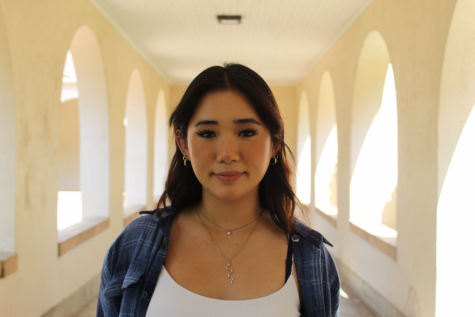
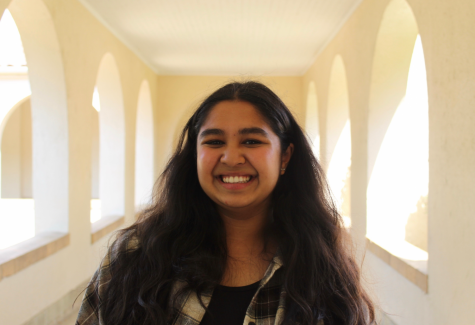
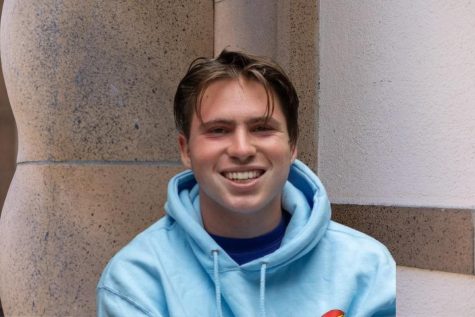
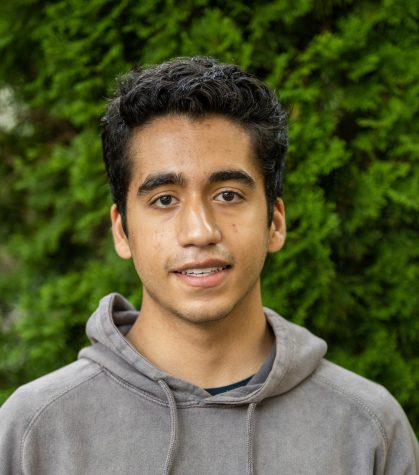

![In the fourth period AP Calculus BC class at Palo Alto High School, senior Crystal Li places her phone in the “phone jail.” Starting July 2026, this may become a normal procedure across schools in California thanks to Governor Gavin Newsom signing the Phone-Free School Act into law last week. According to Li, there are often unnecessary complications that come with enforcing phone restrictions. "It becomes a hassle putting it [a phone] in [the phone jail] before class, and taking it out after class," Li said. "There have been multiple times where kids from other periods interrupt the teacher to come back in and pick up a phone they left."](https://palyvoice.com/wp-content/uploads/2024/09/IMG_7386-3-300x225.jpg)
